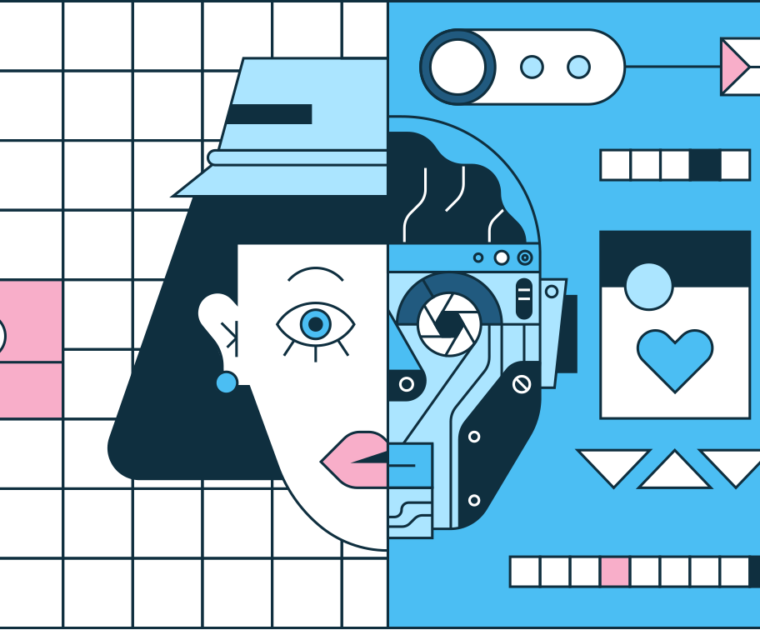The role of creators in marketing has evolved dramatically, becoming central to how brands build trust, engage audiences, and drive ROI. As consumers grow savvier and less tolerant of inauthentic messaging, creators who bring unique strategies, personal stories, and meaningful partnerships to the table are reshaping the influencer landscape.
In this post, we’re looking at four big trends that highlight how creators are no longer just a tool in the marketing toolkit—they’re the key to staying relevant in a crowded, fast-paced digital world.
#1. Creative Becomes the Ultimate ROI Driver.
According to Think With Google, standout creative is now firmly established as the dominant driver of ROI. As privacy protections limit data access and media automation frees up budgets that were once spent on manual processes, creative that stands out and resonates with audiences is now the key differentiator in campaign success.
Why it matters
When all else is automated or restricted, creative is what cuts through the noise. It’s no longer enough to have great targeting or efficient spend—brands need creative that grabs attention, connects emotionally, and compels action. This shift underscores the importance of platform-specific, audience-targeted creative that feels authentic and relevant in the moment.
What to do now
- Invest in creative that’s tailored to each platform, ensuring it aligns with how audiences engage in those spaces. What works on YouTube Shorts might not translate to Instagram Reels or TikTok.
- Collaborate with creators who understand their audiences and can produce content that feels personal and resonant.
- Embrace iterative testing—run multiple variations of creative to see what resonates best, then scale the winning assets.
- Think beyond aesthetics. Focus on creative that delivers a clear message, taps into emotions, and provides value to your audience.
#2 Credibility Is the New Celebrity.
Firsthand experience has become a key criteria for driving visibility. Audiences prioritize those creators who share personal, authentic stories over celebrity endorsements or polished messaging. The demand for authenticity is reshaping not just the influencer space but online behaviors more broadly.
Over the past few years, we’ve watched as platforms like TikTok and Reddit became de facto search engines for younger audiences, who value relatability and firsthand expertise over traditional markers of authority.
Research like the surveys released by Adobe on TikTok and Reddit search behaviors show that firsthand experience often serves as a more critical signal of trust for younger audiences than brand or domain authority.
Recently, we’ve seen similar signals from Google, when knowledge panels for social media content creators began showing up on line, spotlighting the importance of experiential expertise front and center as a driver of brand authority and trust.
Why it matters
71 percent of social/video platform users say they trust an influencer’s authenticity over the size of their audience. Authentic storytelling builds trust and creates deeper emotional connections with audiences, which ultimately drives better engagement and conversions.
What to do now
- Partner with influencers who can connect personal stories to your brand in ways that feel organic and meaningful.
- Shift focus from influencers with large followings to those who prioritize transparency and authenticity in their content.
- Build campaigns around authentic narratives that resonate with your audience’s real-world experiences.
#3 Creators Are Entrepreneurs and Key Opinion Leaders.
Creators aren’t just influencers anymore—they’re CEOs of their own brands. Leveraging their platforms and audience trust, they’re launching businesses, creating products, and becoming key opinion leaders (KOLs) within their niches. From skincare lines to subscription-based platforms, creators are moving beyond sponsored posts to build empires. But this shift isn’t just about influencers launching their own brands—smart companies are embedding creators into their growth strategies, using their insights, expertise, and engaged communities as long-term brand-building assets.
We’ve seen creators like MrBeast turn their influence into full-scale businesses, launching Feastables and MrBeast Burger, proving that creator-led brands can disrupt entire industries. But not every creator is looking to be the next CPG giant—some are becoming KOLs, partnering deeply with brands to shape trends and product development without launching their own companies. Tower 28 Beauty exemplifies this, integrating beauty influencers into their brand strategy, product development, and community-building instead of just paying for one-off promotions.
Why it matters
This shift changes the brand-creator dynamic. Some creators are building their own businesses, while others are stepping into KOL roles, where they influence industries without necessarily selling their own products. In both cases, brands that recognize this shift can partner more strategically, whether through co-creating products, bringing influencers into R&D, or launching long-term ambassador programs.
Take Ali Abdaal, for example. A productivity creator who initially focused on content, he has since built a multi-product ecosystem, offering courses, community-driven products, and digital tools—all informed by his audience’s needs. His business model highlights how influence can evolve into industry expertise, with brands tapping into creators like him for insights and partnerships beyond sponsorships.
What to do now
- For Creators-turned-Entrepreneurs: Look for ways to collaborate beyond traditional sponsorships—think co-branded products, limited-edition drops, or business partnerships.
- For Key Opinion Leaders (KOLs): Engage creators in product development, community engagement, and ongoing brand strategy rather than just hiring them for short-term promotional pushes.
- For Long-Term Brand Growth: Prioritize influencer partnerships that embed creators into the brand’s ecosystem—think ambassador programs, revenue-sharing deals, or advisory roles.
#4 Long-Term Influencer Partnerships Grow in Utility.
Create your short-form content. Have the weeks-long cultural moments. But invest in long-term influencer partnerships. In the olden days, one-off collaborations were typically about driving awareness. But your core audience has likely changed, and relationships trump flash sales every time. Long-term influencer partnerships offer brands something rare: consistency, depth, and cultural resonance. They help extend campaigns, create content ecosystems, and make marketing feel like belonging—super important for younger consumers.
More importantly, long-term relationships drive audiences further down the funnel. Consumers follow influencers through their personal journeys, and when an influencer sticks with a brand over time, their audience starts to see that brand as a natural part of their lifestyle. This is especially crucial for high-barrier-to-entry products—like switching phone providers, investing in luxury items, changing dog foods (iykyk) or making high-commitment lifestyle changes. For products that require trust, research, and consideration, brand ambassadors serve as the bridge between curiosity and conversion.
Why it matters
Long-term partnerships give influencers the time and space to build layered narratives, adding depth and authenticity to brand messaging. These collaborations (and they are collaborations—the brand, influencer, and agency working together to craft a narrative) create opportunities for brands to establish content ecosystems—interconnected stories that span platforms and resonate across audiences.
More importantly, they foster trust. Audiences are far more likely to engage with creators who seamlessly and authentically integrate a brand into their lives. For products with a higher barrier to entry, an influencer’s continued endorsement can help normalize adoption, reduce consumer hesitation, and provide real-world proof of long-term value.
We saw this in action with Sam’s Club, where long-term influencer partnerships were used to drive continued engagement and reinforce brand trust. Influencers didn’t just promote a single shopping trip—they brought their audiences along for multiple visits, demonstrating the everyday value of a membership over time.
What to do now
- Align with influencers who fit your brand’s mission and audience values. Seek out those who can contribute to a long-term narrative, not just a one-off post.
- For high-barrier-to-entry products, prioritize brand ambassadors. Long-term advocacy builds trust and helps audiences feel confident making big purchase decisions.
- Go beyond financial compensation. Offer creative freedom, co-branding opportunities, and exclusive resources that empower influencers to seamlessly integrate your brand into their lives.
- Measure the cumulative impact. Look beyond clicks or views—evaluate how these partnerships shift brand perception, build trust, and foster belonging over time.
- Encourage influencers to expand your brand’s reach. Have them incorporate your product into newsletters, private communities, and in-person events, creating engagement that goes beyond social algorithms.
Conclusion
The way brands work with creators in 2025 isn’t just about visibility—it’s about authenticity, trust, and long-term resonance. From standout creative to meaningful partnerships, these strategies empower brands to connect with audiences on a deeper level.
If you’re ready to embrace the future of creator-led strategies, start by identifying collaborators who align with your values and audience. Lean into storytelling that feels real, and invest in partnerships that evolve over time. The results? Creative campaigns that break through the noise and build lasting brand loyalty.
Explore how your brand can harness creator-driven strategies to lead in 2025—connect with us today to get started.







